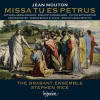Texte paru dans: / Appeared in:
*

International Record Review - (06/2012)
Pour
s'abonner / Subscription information
Hyperion
CDA67933

I have not seen any of the extravagant bodice-ripping TV series The Borgias, but apparently the music heard accompanying the coronation of Pope Alexander VI (in 1492) is Handel’s anthem Zadok the Priest, written a mere 235 years later. Had Jean Mouton’s Missa ‘Tu es Petrus’ been used instead, viewers would have a much better idea of how sacred music of that period actually sounded. (No doubt some stickler — possibly me — would have pointed out that this too was anachronistic, as Mouton’s patron was the slightly later Pope Leo X, who reigned from 1513 to 1521 .) In fact, the elevation of Mouton (ante 1459-1522) to royal and papal favour came rather late in his career, most of which he had spent as a provincial chapel master. His outstanding talents were recognized in 1502 by the French Queen Anne of Brittany, who employed him until her death in 1514, and in whose honour he composed a deeply moving Requiem. The widowed King Louis XII retained Mouton, who by this stage also supplied compositions to the new Pope. Leo X was a serious musical connoisseur, if not the paragon Mouton celebrates in his motet Exsultet coniubilando.
This recording includes all Mouton’s motets written in eight parts, as well as the Missa ‘Tu es Petrus’, and the notes by Stephen Rice, The Brabant Ensemble’s director, explain with exemplary clarity their dazzling technical achievements. (Dr Rice’s essay also contains welcome flashes of humour, including a series of multilingual puns in the final sentence.) Among the most accomplished works of the sixteenth century in terms of its canonic structure is Mouton’s Christmas antiphon Nesciens mater and it is not surprising it has been chosen as the opening piece on the CD . This work of quietly concentrated brilliance is so well matched in mood by the following motet Ave Maria, gemma virginum that one could almost imagine them as two halves of the same work.
This contemplative pair is followed by the exuberant motet in honour of Pope Leo mentioned above, which was written in somewhat archaic style. Interestingly, this joyous work was too good even for later Lutherans to overlook. Rice mentions a copy surviving in Nuremberg with the offending papist text subtly altered for local sensibilities. Verbum bonum et suave is a long and elaborate setting of an ancient Sequence for the feast of the Annunciation. One of the last such polyphonic settings before the Council of Trent abolished all but four Sequences, it has many attractive and interesting features, not least the soaring ‘Amen’ with which it concludes.
In each of these rich and complex works, the lucidity of both The Brabant Ensemble’s singing and Rice’s direction is hugely impressive. Polyphony written in so many parts can often sound dense and obscure (albeit ravishing to the ear). Measured tempos and highly disciplined singing, unhampered by vibrato, ensure that all parts are clearly distinguishable. Indeed, thanks to excellent diction, even the texts can be followed without great difficulty. The moderately French pronunciation of Latin adopted by the Ensemble, most noticeable in the ‘c’ and ‘u’ sounds, is both authentic and pleasingly emollient.
After this run of works in eight parts, the five-voiced Missa ‘Tu es Petrus’ sounds positively lightly textured. Four voices swirl around the fifth, which sings the cantus firmus: this is set in an unusually high tessitura, resulting in a work of radiance and clarity. Of course, female voices in the upper parts are not what Mouton or Leo X would have heard; but the Brabantine sopranos and altos have a far more boyish quality than many other such choirs. The recital ends with two of Mouton’s motets in four parts: Factum est silentium, a strikingly vivid and modern depiction of Archangel Michael’s defeat of the dragon, and the engaging Bona vita, bona refectio, which celebrates pious conviviality among clerical friends. Again, both are strikingly well sung.
For many years, Hyperion has been a good friend to lovers
of Renaissance sacred polyphony, particularly with its outstanding
recordings with Westminster Cathedral Choir. Lately that choir seems to have
developed a severe case of the musical wobbles (temporary, one hopes); so it
is very gratifying that with The Brabant Ensemble from England and
Cinquecento from the Continent, Hyperion is still setting the standard in
this infinitely rewarding repertory.
Fermer la fenêtre/Close window
Cliquez l'un ou l'autre
bouton pour découvrir bien d'autres critiques de CD
Click either button for many other reviews



